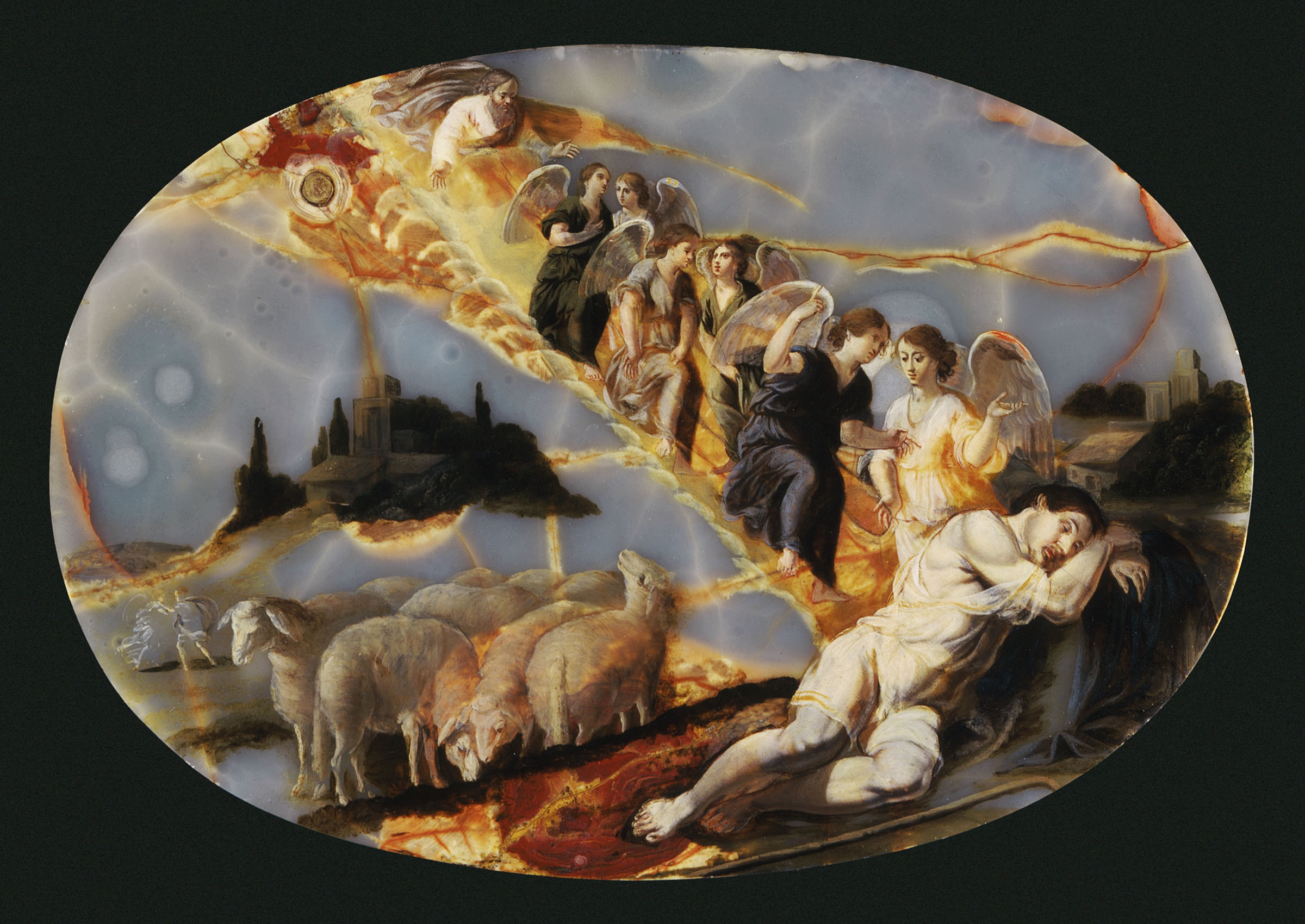 |
| Jacques Stella, Jacob's Ladder, about 1560. Oil on onyx. LACMA |
LACMA's trippiest French baroque painting is Jacques Stella's Jacob's Ladder. Stella was a friend of Poussin's who served as royal painter to Louis XIII and lived in the Louvre. He spent part of his early career in Florence, where he was exposed to the Medici court's taste for hardstone mosaics. This prompted Stella to produce a number of oil paintings on stone. In the LACMA picture, Stella uses an oval of murky blue-gray onyx with flame-like streaks as a support for a painting of Jacob and his ladder to heaven. Only about half the surface is painted: Stella was smart enough to let onyx be onyx. The hybrid result is one of the strangest pictures of its time.
LACMA's "Eternal Medium: Seeing the World in Stone" surveys the appreciation of stone as a pictorial medium, primarily in Europe but with excursions to China, India, Egypt, and the Americas. Some 125 works span figured stone, with and without artistic emendations, and pietre dure, a jigsaw-like mosaic of colored hardstones. The exhibition is part of the ongoing rapprochement of LACMA and the foundation established by
estranged trustee Arthur Gilbert. LACMA curator Rosie Mills organized the show, drawing on the Gilbert collection (promised, then unpromised to LACMA and now at London's Victoria and Albert Museum), the V&A collection, and LACMA's holdings.
 |
| Unknown, marble slab from Yunnan province, China, about 1800–1872. Victoria and Albert Museum, London |
Pareidolia is the word for perceiving images in random data—seeing animals in clouds, portents in tea leaves, or Jesus in a tortilla. Pareidolia was part of the Surrealists' toolkit, but its history in art is much older. The mountains near Dali in China's Yunnan province were long prized for figurative marble held to resemble ink landscape paintings. Slabs of Dali marble were inset in furniture and displayed as self-contained pictures.
Italy had similar reverence for colored marble and hardstones. Stone from Roman ruins was recycled into tabletops and chessboards sold to Grand Tourists.
 |
| Unknown, mosaic tabletop, 1850–1900. LACMA |
 |
| Daniel Baudesson (goldsmith), Snuffbox, 1760–65. Rosalinde and Arthur Gilbert Collection on loan to Victoria and Albert Museum |
 |
| Renato Bittoni (designer), Valchirie, about 1954. |
Florence has produced pictures of cut stone continuously since 1588. Examples here range from a 1600-01 portrait of Pope Clement VIII to a kitschy 1928 genre scene,
Return from the Market. More interesting is small panel of Wagnerian riders slouching towards modernism. Designed by Renato Bittoni, it is composed of white chalcedony, gabbro, and other stones.
 |
| Montici workshop, Richard Blow, owner and designer. Untitled (Landscape), about 1960. LACMA |
The albarese limestone of Tuscany is known as "landscape stone" for its resemblance to mountainous topography. American artist Richard Blow tweaked the tradition by incorporating a slice of figured limestone into a trompe l'oeil stone mosaic. The curling edges and shadows are stone. This is a recent gift to LACMA from the Gilbert Foundation, as is a snuffbox in the form of jewel-eyed dog.
 |
| Unknown, Snuffbox in the Shape of a Dog, Germany, about 1740–50. LACMA, gift of Rosalinde and Arthur Gilbert Foundation and the 2022 Decorative Arts and Design Acquisitions Committee. Photo © Museum Associates/LACMA |
 |
| Analia Saban, Draped Marble (Carrara, St. Laurant, Brown Onyx), 2016. LACMA |
One of the few contemporary pieces, Analia Saban's Draped Marble, displays the ongoing fascination with out-of-context stone.
 |
| Installation view, with projected enlargement of Dioskourides' carved gem of Demosthenes at far right |
The exhibition has a lighting problem. Despite the "eternal medium" billing, there are enough light sensitive works that the lighting must be kept dim. The design of the display cases casts half of the overhead-lit labels into illegible shadow. Many small snuffboxes and gems are far from any but the shortest visitors' eyes. Magnifying glasses are supplied, but they don't help much when a tiny object is in a big display case. The Getty Villa's spectacular
carved amethyst of Demosthenes, by Dioskourides—less than an inch high—is almost invisible save in a large projected image on the wall.
 |
| Unknown, Mughal Empire, India. Bowl with Handles, about 1640–50. LACMA |
Here's a piece with perfect lighting. It's a jade bowl from the reign of Mughal Emperor Shah Jahan, with a translucent floral design visible only when backlighted.
"Eternal Medium: Seeing the World in Stone" is in the Resnick Pavilion through Feb. 11, 2024.










Comments